After Argentina invaded the Falkland Islands in 1982, the British frantically prepared their fleet to sail to the South Atlantic and recapture them. The 8,000-mile logistics chain included only one base, Ascension, a tiny island in the central Atlantic.1
Ascension was critical to Britain's counterinvasion of the Falklands, providing the base where the Task Force assembled and sorted itself out after its hasty departure from the UK. Ascension was primarily used as a base by the Americans, who had a NASA tracking station and a signals intelligence center on the island. Wideawake Airfield, with a 10,000 ft runway, would be vital. Although the runway was enough to support virtually any airplane, it had no taxiway and only a small hardstand, and the operations contract with Pan Am provided for only 285 aircraft movements per year. At the height of the operation, Wideawake would see more than 300 aircraft movements in a day, making it the busiest airport in the world.
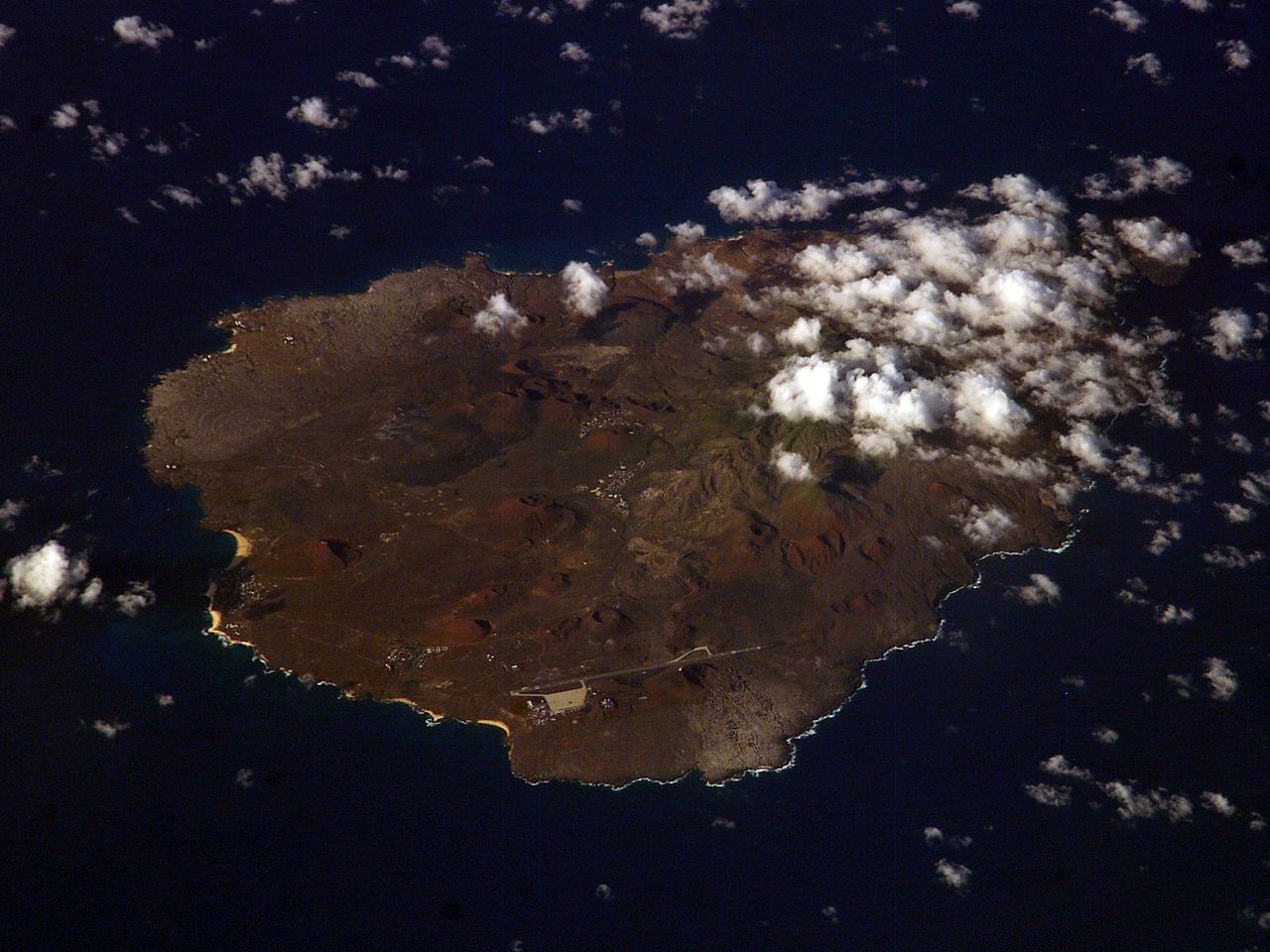
Ascension viewed from the ISS, with Wideawake at the bottom
Ascension's other facilities were equally bare-bones. There were no hotels, and visitors were not allowed without permission from the British Administrator. Children reaching 18 who were not employed were required to leave. There was a golf course, but it was among the worst in the world due to the lack of greenery.2 Ascension did not have the facilities to support a large influx of visitors: the island's supply of fresh water, produced by desalination, was very limited, and there was virtually no shelter for the new arrivals.
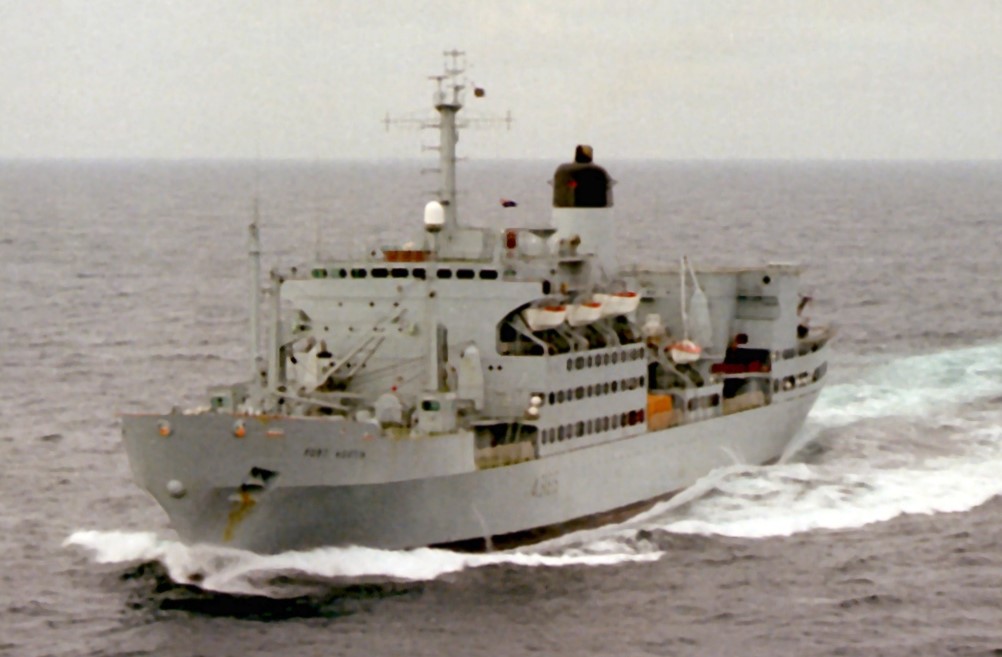
RFA Fort Austin
On April 9th, RFA Fort Austin became the first vessel to pass Ascension, heading south to meet up with Endurance. She took onboard a trio of Lynx helicopters, armed with the Sea Skua anti-ship missile. The Sea Skua had not yet been fully cleared for service, but these helicopters provided vital protection to the unarmed supply ship as it entered the combat zone. Three days after departing Ascension, Fort Austin rendezvoused with Endurance, then down to two day's worth of food, and transferred over 200 loads by cable and helicopter. The next day, during a series of transfers running from morning until midnight, another 300 loads went to Antrim, Plymouth and Tidespring, headed south to liberate South Georgia. The afternoon of the 14th, less than a day later, saw a third series of transfers begin, 380 loads to the main surface task force of Sheffield, Brilliant, Glasgow, Coventry and Arrow. The RFA took aboard 200 loads to backhaul to Ascension during this process, everything from training ammunition to excess paint, and possibly including several nuclear depth charges carried aboard the ships.3 She dropped this backhaul off and took on another 480 loads within 48 hours before heading south again, one of many tankers and supply ships that kept the force operating.
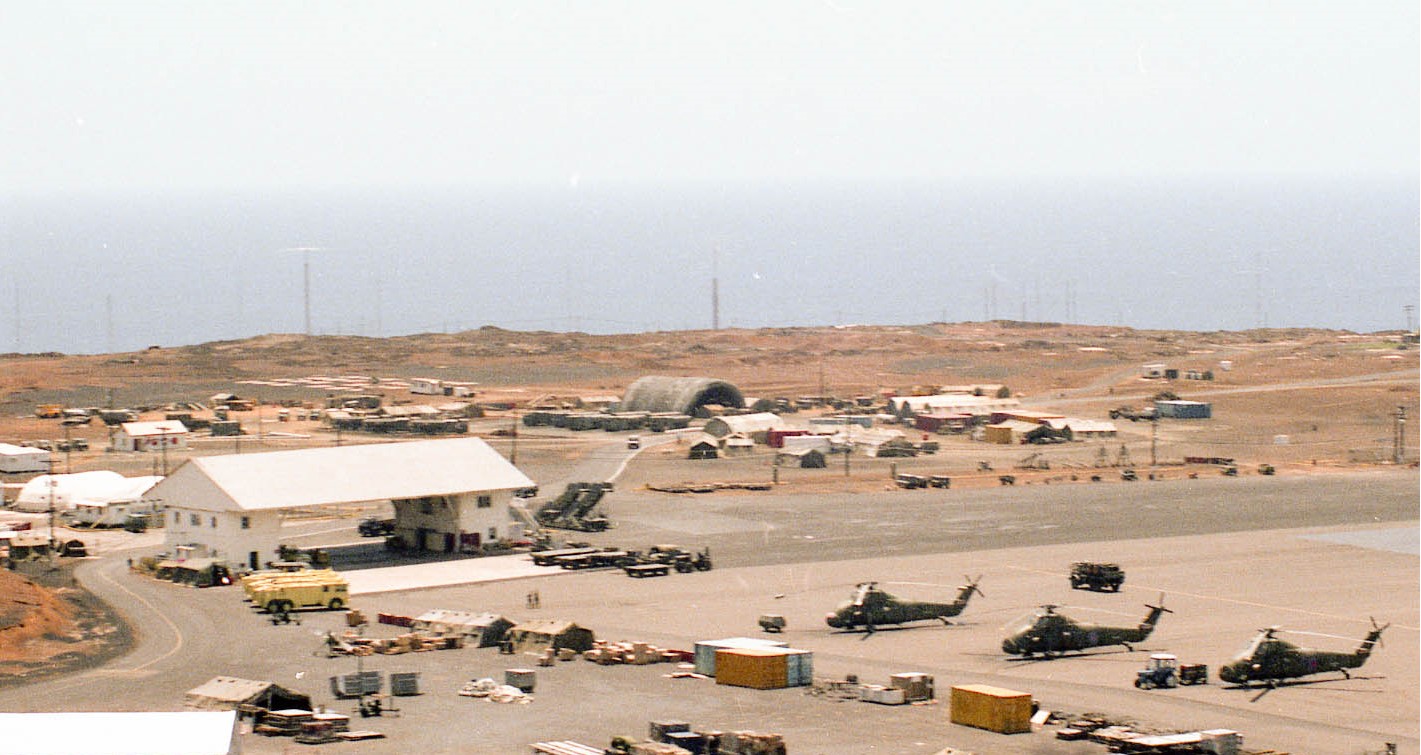
Wideawake airfield
Beginning at midnight on April 13th, the British declared a Maritime Exclusion Zone in the 200 nautical miles around the Falklands. The nuclear submarines had arrived, and any vessels, naval or merchant, were to navigate it at their own risk. The Argentinians withdrew their larger warships, but chanced a few last runs with some of their state-owned merchant ships. The British, unwilling to sink merchant ships without warning, and equally unwilling to give away their position by warning the ships, let them pass. This allowed the invaders to continue their efforts to build up the island's defenses, including minefields and formidable air defense assets.
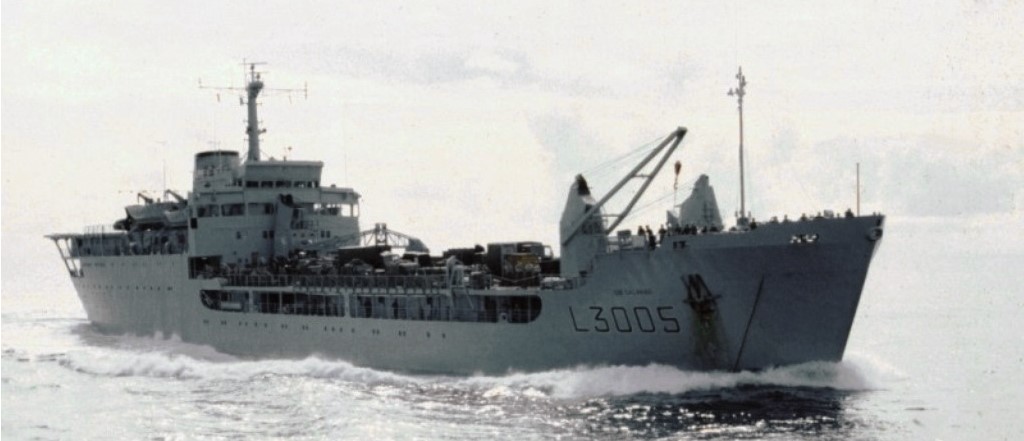
LSL Sir Galahad
The three days later, Hermes and Invincible arrived at Ascension, followed the next day by Fearless, Stromness and the LSLs. The carriers spent the next day hurriedly offloading supplies to the amphibious force, before the carrier group, now designated TG 317.8, headed south, in an attempt to establish air and sea superiority before the amphibious group arrived. The amphibious group spent the next two weeks frantically shifting supplies around as more forces trickled in.
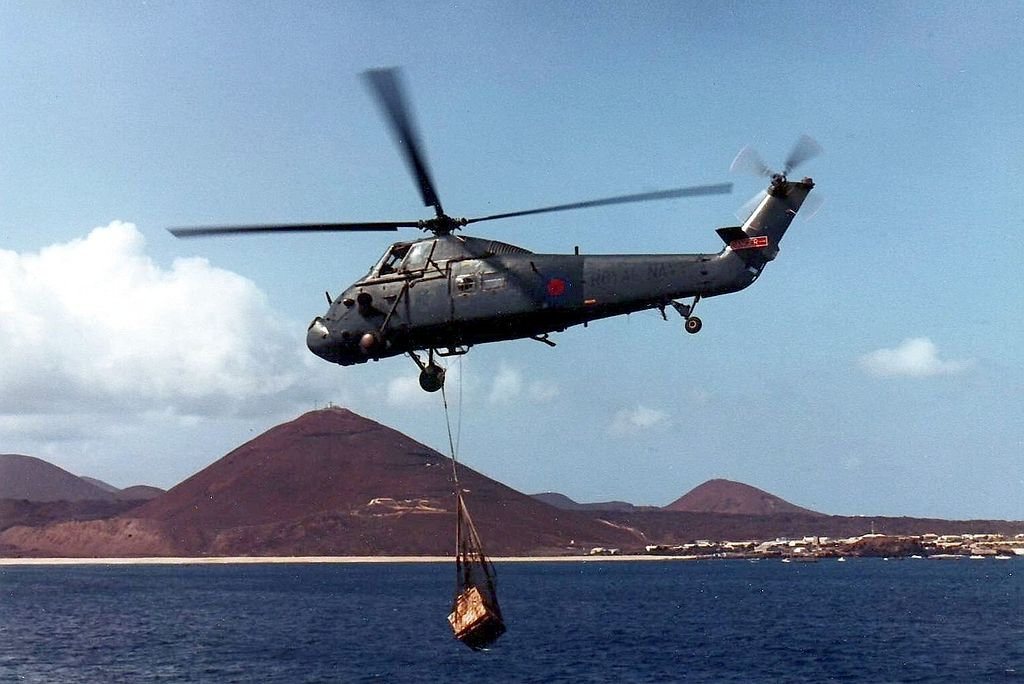
Wessex carrying supplies at Ascension
The port facilities they had to deal with were, if anything, worse than the rest of Ascension. A single stone jetty at the capital, Georgetown, was the only way on and off the island through the heavy swells of the Atlantic. The fleet, wanting to pick up extra equipment and supplies flown out to Wideawake, had to anchor offshore and ferry it out in nets slung below their helicopters. Throughout the entire campaign, helicopters performed a vital logistical function. The destroyers and frigates that sailed from Gibraltar had been stored at least partially by helicopter, and they allowed the transfer of personnel and supplies between ships and to shore much more easily than had been the case in previous wars.
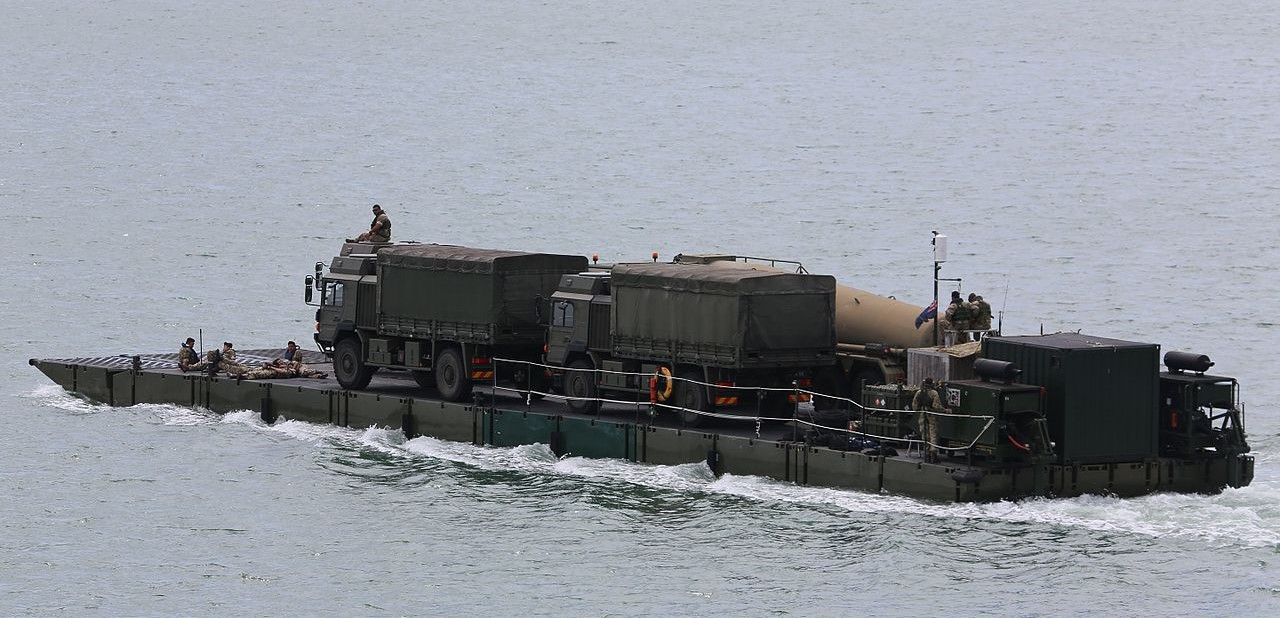
A Mexeflote
The main problem with helicopters was their limited carrying capacity. Due to the speed with which the task force had been loaded, there was a desperate need to sort out where everything was before an amphibious landing was attempted, and this was also carried out near Ascension. The most useful vessels for the task, the landing craft carried by the LPDs, were initially unavailable, as the LPDs had burned so much fuel that they couldn't ballast down far enough to launch them. Instead, Mexeflotes that had come south on the sides of the LSLs had to be used. In at least a few cases, fear of Argentine air or submarine attack forced the ships to weigh anchor and head to sea for the night, leaving the mexeflotes on their own.
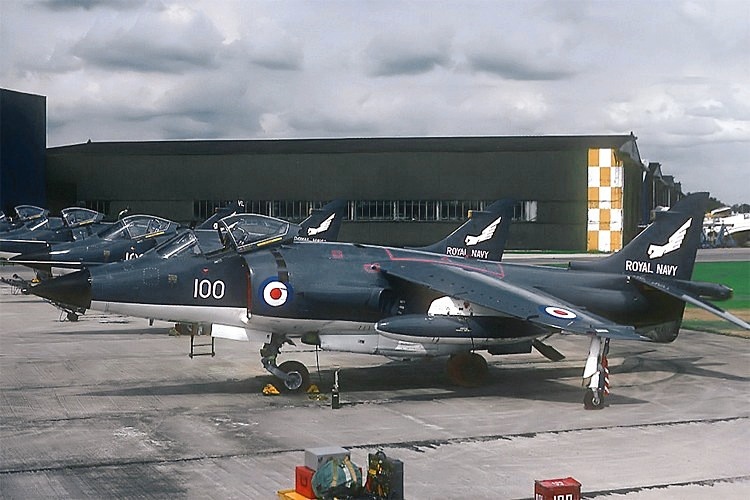
Sea Harriers before the war
Hermes and Invincible had aboard 12 and 8 Sea Harriers respectively, but it quickly became obvious that this wasn't enough. To reinforce them, eight more were scrounged up from various places in the UK4 and the RAF contributed 10 Harrier GR.3s, which had to be hastily modified for carrier operations. Their undercarriages were strengthened, holes were drilled in strategic places to make sure that corrosive salt water would drain off, and the wiring to carry Sidewinder missiles was fitted. The RAF pilots were equally hastily trained in deck takeoffs and landings using the facilities ashore.
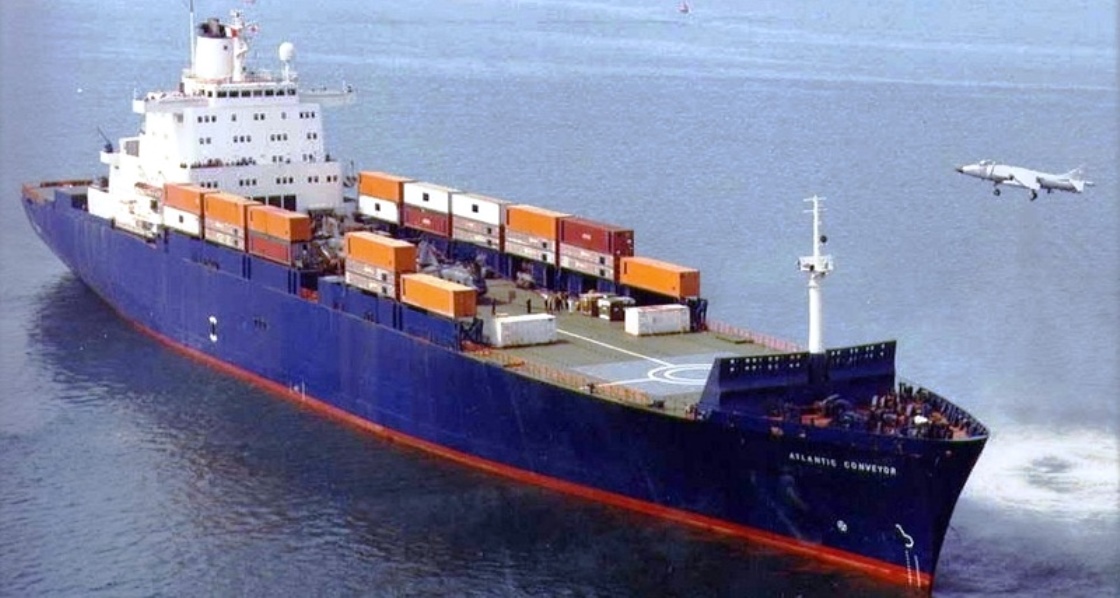
Atlantic Conveyor carrying out Sea Harrier trials
To carry the extra Harriers south, and to reinforce the helicopter assets of the Task Force, another merchant ship was needed, and a Cunard container ship by the name of Atlantic Conveyor was selected. Containers were stacked to provide workshops and shelter for the embarked aircraft, and she was loaded with supplies. She departed the UK on April 25th, carrying six Wessex and five Chinook helicopters. The Sea Harriers and six of the RAF Harriers were flown down to Ascension to meet the ship on her arrival on May 5th.5 She was joined there by HMS Intrepid, an LPD that had been decommissioned and destored when the war began. Portland Naval Base had returned her to service in a mere 22 days.
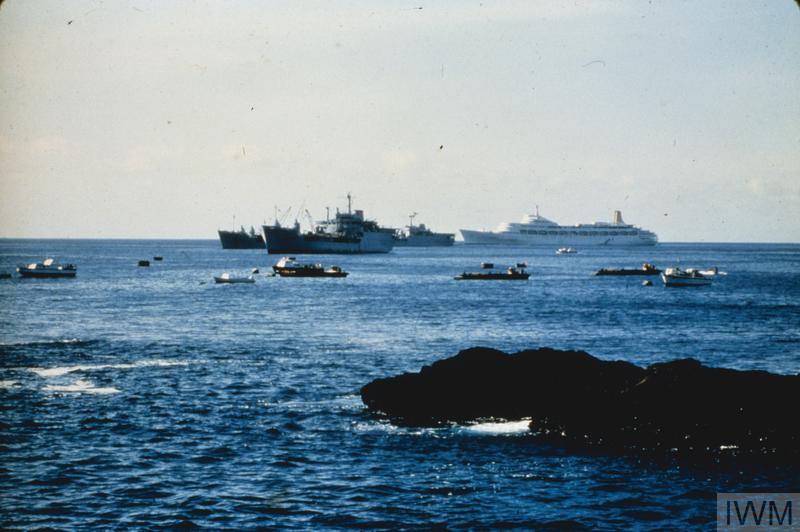
Shipping off Ascension, including Canberra.
The amphibious force was completed with the arrival of MV Norland on the morning of May 7th. She had been planned to sail with Intrepid, but was delayed by a 24-hour strike in Hull while under conversion, the only one of the entire war.6 Even before her arrival, the force tasked with the actual landing had begun to head south. The slow LSLs had departed on May 1st, to avoid delaying the other ships during the passage. Norland remained near Ascension just long enough to give her passengers, 2 Para, a quick amphibious drill, and then the entire Task Force weighed anchor and headed for the Falklands.
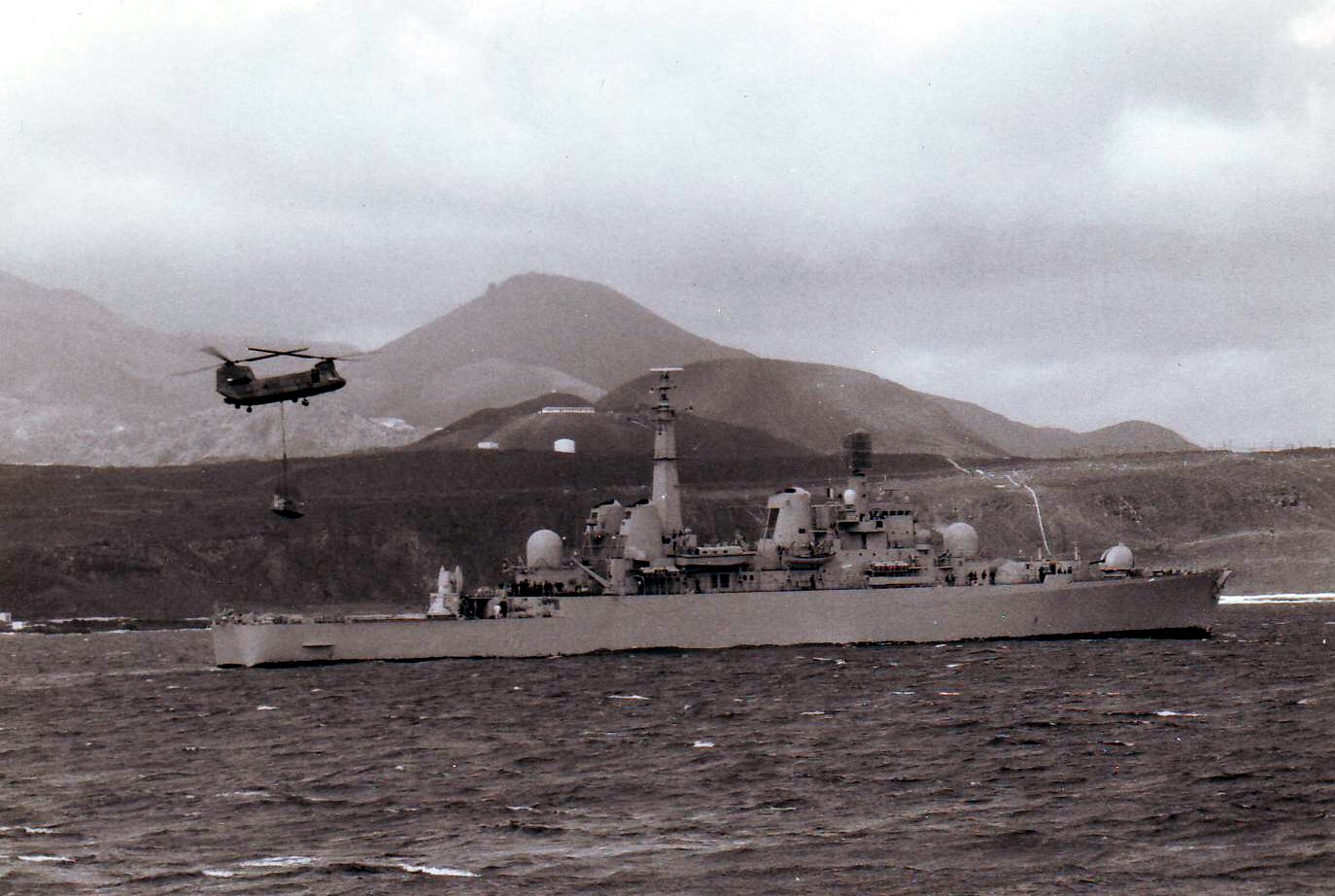
HMS Bristol being loaded at Ascension towards the end of the war.
Ascension would continue to play a vital role in sustaining the Task Force as it mounted the invasions of South Georgia and the Falklands themselves. More ships would follow the carriers and amphibious group south, and airplanes operating out of Wideawake would provide support and deliver urgent supplies through mid-air refueling, as well as carrying out one of the greatest bombing missions ever. But next we must turn our attention to the first phase of the British offensive, the recapture of South Georgia.
1 I've written a glossary to make it easier to keep track of terms in this series, and the full list of posts is here. ⇑
2 It was a facility run by the US Air Force. Of course there was a golf course. ⇑
3 Before you laugh, the USN discovered off Guadalcanal that the paint locker is one of the greatest fire hazards on a ship. ⇑
4 34 Sea Harriers had been ordered. One was still under construction, and one had been lost in an accident, leaving only 4 in the UK for training and trials. ⇑
5 This was to reduce their exposure to salt water, which is a nasty and corrosive substance. ⇑
6 Given what I know of British unions at the time, this was a minor miracle. ⇑

Comments
You write that the Sea Harriers and helicopters were flown out to Ascension Island to meet the Atlantic Conveyor - which raises the question, flown from where? The nearest suitable British base is I believe Gibraltar, which is ~3000 nm away, and the ferry range of a Sea Harrier is less than 2000 nm.
Mid-air refueling. The Sea Harriers were flown with one ground stop (my book doesn't say where) while the RAF Harriers flew direct.
Slight correction- the missile is the Sea Skua- a skua is a predatory seabird of the genus Stercorarius, while suka is something rude in Russian.
What do you make of that? It seems like an odd sort of scruples to not be willing to sink enemy transports.
Oops. Looks like I've been getting that wrong for years. No clue why.
It was PR-driven. Look at the whining over the Belgrano, 35 years later, and that was an actual warship, with guns and everything. Some of the stupider elements of British society believe the Argentinian Government when they say it was just a routine training cruise, intended to entertain orphans and introduce puppies and kittens to maritime life. (OK, that last bit was sarcasm.) But I'm pretty sure that any transport sunk outbound would have been loaded with puppies and medical supplies for the Islanders, while any sunk on the way back would have been evacuating widows and orphans. The British war effort was dependent on not angering public opinion, particularly in the US, and sinking unarmed merchant ships without warning would have been very bad there.
I've really been enjoying (and learning a lot from) this series. Looking forward to the next installment!
Surely even without PR constraints, it's better to achieve you objectives with the minimum loss of life--even the lives of enemy combatants, if you can manage it?
@Suvorov
Thanks. It's been interesting to write, too.
@ADifferentAnonymous
In this day and age, nobody goes intentionally hunting for enemies to kill, just for the sake of killing them. But you'd better believe those transports were carrying things other than puppies, medical supplies, orphans, and widows. And allowing that stuff (ammo, radars, engineering supplies, etc) through made it harder and more costly in lives for the British to retake the islands later on. It's vaguely possible that as things turned out, it was a net positive in terms of total not-deaths to not sink the transports, but that's a grossly unrealistic standard to hold a military operation to.
I sometimes wonder if this is why we haven't really won any of our most recent conflicts. Against a defined conventional enemy, fighting for essentially defensive purposes, like the Falklands or Kuwait, then we can put humanitarian and PR considerations at the front.
However, for less well defined operations putting collateral damage minimization as the primary objective seems to have really handicapped our ability to make use of our tactical superiority. I'm not saying we should go out and start killing for the sake of it, but at the same time war is war, and I think the modern west has an unrealistic ideal of how surgical we can make a war while still trying to win.
Why British submarines were so reluctant to surface to warn Argentinean transports? Considering Argentinean navy already ran home, there wasn't really any naval combatants in the area who could pose a serious threat to SSN.
One reason I could think of is captain's concern for non-impossible situation: what if the boat would surface, ask the transport to go it's merry way "or else", but the transport wouldn't comply? Sink her? A PR disaster. Allow them to proceed? Another kind of PR disaster. And the act of surfacing itself would put the submarine in a precarious position, so they couldn't exactly loiter. So, surfacing would've been a bad move however the situation might develop.
@RedRover
That's a definite problem, and one I think has been serious in Iraq. I'm certainly not in favor of wholesale slaughter of civilians, but all the whining about families of terrorist leaders killed in drone strikes forgets the basic fact that people die in war, and a lot of them are people who just happened to be in the wrong place, who we don't necessarily want to kill.
@Inky
If submarines still had deck guns, they'd have done just that. But SSNs are ruthlessly optimized for underwater operation, and are slow and clumsy on the surface. Every piece of doctrine they have says that they shouldn't reveal their position, except by blowing up their target. They also don't have the capability to do things like put boarding parties aboard hostile ships. And the problem wasn't naval combatants so much as the risk of a ship being "slow to comply" and whistling up an airplane, which is a lot more of a threat than it was in WWI or the early part of WWII, when submarines last tried to follow prize rules, because of better comms and faster planes.
I can't help but think of World War 1 where German submarines sinking civilian ships was one of the very points that led to the USA concluding that the Germans were "the bad guys" and hence to coming in on the English side. Not that the USA was going to enter the war as an Argentinian ally, but the British wanted to keep them as a British ally.
The same thought occurred to me, and I'm sure it was in the minds of those in Downing Street and Whitehall.
@bean
Is a non-dedicated ASW aircraft all that big of a threat to a submarine? A helicopter would take quite some time to arrive, and SSN would have likely been warned of an impending threat. Evading an anti-ship missile is as simple as diving. And torpedo bombers don't even exist as a class of aircraft anymore, mostly due to success of anti-ship missiles. I didn't found mentions of any jet airplanes capable of carrying airborne-launched torpedoes, they seem to be limited to specialized ASW craft, that is helicopters and Poseidon and the like. Interestingly enough, during the Falkland campaign, AAF tried to fit some of its light turboprop aircraft with torpedo pylons, but war was over before any converted aircraft entered service.
Argentina had at least a couple of SP-2H Neptunes, which had ASW capability. Specifically, it could carry light homing torpedoes, probably Mk 44s based on the era. I wouldn't be so quick to dismiss the ASM threat, either. Diving takes time, maybe enough to let the plane (or the missile) reach the submarine. For that matter, a low-flying Skyhawk armed with bombs might be a serious threat to the submarine. I don't think modern submarines carry air search radars, which makes it really hard to pick one up in time to dive if it's careful about how it makes its approach.
And the Pucara-as-torpedo platform thing apparently was a case of Argentina drinking their own cool-aid. They lost a plane and pilot to a British bombing raid, and started claiming that he was shot down attacking Hermes, which he damaged. They then somehow convinced themselves that the Pucara was a good torpedo platform because of this entirely fictions attack.
@bean
It seems like part of the problem is our own confused approach; we send the military to grab foreign hostiles out of a warzone and then try them for federal crimes. That may work fairly well for getting terrorists into federal courts, but I'm not sure it works well for convincing the homefront we are fighting a war, especially when our leaders seem to shy away from that rhetoric. Maybe the current approach is the best of all possible approaches, but it doesn't seem geared to contextualize civilian casualties very well.
@RedRover
My .02: I think it's worth pointing out that Russians, who don't seem nearly as dedicated to "surgical" approaches or collateral damage minimization, have had limited success when confronted with similar problems. As far as I can tell, they managed to keep Chechnya in the Russian federation (which, obviously, is very important) but failed at, uh, Russianizing Chechnya and pretty much just let them do their own thing at this point. While I'm sympathetic to your line of reasoning, I'm not sure that the West has a realistic shot of achieving a lot of its current apparent goals outside of its own territories at all regardless of its commitment to winning.
Wouldn't even a strafing run with heavy machine guns or autocannons have the potential to be fairly effective if you caught a submarine on the surface? I'm sure that it was very plausible for civilian ships to be carrying HMGs belowdecks, too.
I'm not a counterinsurgency expert, so I'm just going to round off to "COIN is hard" and stop there.
Less than you'd think, actually. Because they're designed to withstand the pressure of diving, submarines have thick hulls. While they're obviously vulnerable to damage to anything or anyone on the outside of the pressure hull, the submarine itself is not in danger from anything short of an anti-tank cannon.
However, this line of discussion misses something critical, which I should have pushed harder early on. Chapter 1 of "How to operate an SSN" as used by all major navies is "THOU SHALT NOT ALLOW THYSELF TO BE DETECTED" in 64-point type, repeated across 10 pages. While it might not actually be a totally terrible idea to try surfacing to force the ship to surrender, it runs totally contrary to all doctrine and training for SSNs. And there's the risk that the second ship which tries it is a Q-ship with a couple of airplanes waiting just over the horizon and a bunch of ATGMs on deck.
@bean
Not that you would ever do it, but would a LAW/SMAW type thing be enough to prevent an SSN from diving if it managed to hit the submarine? I imagine the obliquity of the hull when surfaced would largely work in favor of the SSN, but it still seems like the pressure hull would be at risk from a direct hit. (From a quick google, it appears the pressure hull is about 3" of steel, but you have the spacing effect of outer hull, which would probably reduce the strength of any explosion somewhat.)
This makes me wonder: Would it be possible to design a system for submarines to make ships surrender? My first thought is a modified torpedo that would home on the ship, surface next to it, and broadcast a radio message from the submarine. Not sure what the message would say, though--all else fails, "Please evacuate all personnel, we will sink your ship in X minutes" might be an option.
Also, stupidest question of the thread coming up: Can you ping in Morse code? You'd still be detected, but you wouldn't have to surface, and you'd only be precisely located if a vessel with a proper sonar were around, right?
Not really sure. Probably depends on the submarine and (as you identify) the angle. I certainly wouldn't want to dive too deeply after a hit, but I also suspect that the crew could probably seal off the compartment or do some other improvised repair. They certainly wouldn't go to full operating depth, but they probably wouldn't be trapped on the surface, either.
Something like that is vaguely possible, but I'm not sure how much it helps. You've still announced your presence, which is a serious sin in the submarine world, and while you aren't vulnerable to strafing runs or ATGMs, you've still made yourself a lot easier for the nearest patrol airplane to find. There's also the issue of compliance. Traditional prize rules require you to board the ship and put the passengers and crew in a place of safety first (which means more than lifeboats, particularly in the South Atlantic). Even if that isn't possible, you have a lot less territory between "ask politely" and "kill them all, God will know his own", than is feasible for a surface ship. They're a lot more likely to call your bluff, and it's messier if they do.
It would certainly be possible to do it. The problem is again one of international law and public opinion. One of the advantages of the traditional method of showing up at short range with a warship is that it makes it very obvious what's going on. If the Argentinians are feeling particularly unpleasant, they'll ignore it, and claim they didn't know what it meant after the torpedo hits.
I also should point out that this kind of thing is pretty rare. In a superpower war, nobody is going to bother with prize rules or this kind of scruple, period. In a lesser war, there would almost always be surface units available to back up the subs.
@bean Echoing the comment about unrestricted submarine warfare have very bad optics. People still think of the sinking of the Lusitania as being barbaric 100 years later, despite that ship being specifically warned and transporting military supplies(!). Also, I think you should avoid the use of the word “whining” when talking about people killed during military actions, as it really comes off poorly, and seems difficult to define.
@RedRover I take issue with the idea that western powers haven’t “won” any recent conflicts. The US has handily won every major military conflict since Vietnam. The issue of governance, i.e. what you do after you win, has been the intractable problem.
@chuck
Tactically, we've won almost every engagement. We reached Baghdad in something like three weeks, and destroyed the Afghan government (to the extent it had such a thing) in a few months. However, given our inability to achieve our stated ends, as far as being able to withdraw without creating chaos, I still think they have to count as losses, or at best draws, strategically. Perhaps we were really fighting for more limited ends, but I don't think that matches the reality or the rhetoric.
Lusitania marked a major change in how submarine warfare was conducted, which lead to it becoming the horror that it was during WWII. That said, I can't condemn it too strongly, as I applaud the American submariners who did the same thing 30 years later.
I don't always speak as carefully as I should, particularly in the comments. (He who is without sin...) I do think that getting all up in arms about a drone strike, which is by any objective measure the lowest collateral damage, cleanest method of warfare ever invented, killing a few people besides the intended target, is rather bizarre. Particularly when the target is usually a member of an organization that wants to slaughter our civilians indiscriminately.
The big difference, I think, is that Lusitania was a neutral. I may be wrong here, but my impression is that the US submariners who strangled Japan were operating in an area that no neutral ship would willingly be within a thousand miles of.
No, Lusitania wasn't a neutral. She was British-flagged, and distinctive enough that there was little question as to her identity, which is both a good and bad thing. (The Germans weren't accidentally shooting at a neutral, but they also knew she was a liner, even if she had small arms ammo onboard.)
As an aside I forgot to mention earlier, there wasn't a specific warning about Lusitania. The German Embassy placed a "proceed at your own risk" ad, which happened to be next to Lusitania's in at least some papers.
Interestingly, this isn't quite true. In the Sea of Okhotsk and surrounding areas, there were lots of Soviet ships running around (the USSR didn't join the war with Japan until August of 1945), and it gave the Americans headaches. They were usually running with lights on, but it still took time to make sure they weren't Japanese. But that's not where the bulk of the submarine war took place.
@ADifferentAnonymous
Not so surely, no. Even if you set aside that being perceived to be moral rather than immoral is pretty important to almost everyone (human beings are social creatures after all), the morality of particular actions also depends on your approach to ethics. From a consequentialist approach (which is the one I tend towards) you're correct, but from a deontological approach it may be more moral to, e.g., let more people die so long as you're not the one killing them or the one breaking international laws or norms or whatever.
@bean
Well, for a start drone strikes are, if not actually assassination, awfully close to it. A fairly strict consequentialist like me would say, "have at it" and accept even fairly substantial collateral damage if it seemed clearly enough to be reducing civilian casualties in the long run, but not everybody thinks that way and, of course, there's plenty of space for valid disagreements on the calculation of how many civilian deaths were avoided.
And there's also the issue that, once you get started on the drone/assassination/whatever thing, it's awfully easy to let it go further than you had intended at the start. I'm not sure that "oops, we just dropped a bomb on a near-completely innocent wedding party" goes over well in any system of moral analysis.
I recently finished reading Ronen Ergman's excellent book Rise and Kill First, which discusses Israel's targeted killing strategy over the last many decades. (They were probably one of the first to make extensive use of drones for assistance in these strikes. The U.S. didn't look too kindly on the technique at first; unsurprisingly the U.S. changed its tune in the decade after 9/11.) Many of the different effects, both good and horrible, that can come out of such a strategy come up in his detailed history and analysis. It's quite enlightening and I can highly recommend it.